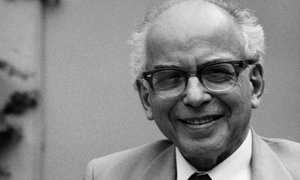George Perle

George Perle (May 6, 1915 – January 23, 2009) was a composer and music theorist.
Biography
Perle was born in Bayonne, New Jersey. He graduated from DePaul University, where he studied with Wesley LaViolette and received private lessons from Ernst Krenek.[1]
Perle composed with a technique of his own devising called "twelve-tone tonality". This technique was different from, but related to, the twelve-tone technique of the Second Viennese School,[2] of which he was an "early admirer" and whose techniques he used aspects of but never fully adopted.[3] Perle's former student Paul Lansky described Perle's twelve-tone tonality thus:
Basically this creates a hierarchy among the notes of the chromatic scale so that they are all referentially related to one or two pitches which then function as a tonic note or chord in tonality. The system similarly creates a hierarchy among intervals and finally, among larger collections of notes, 'chords.' The main debt of this system to the 12-tone system lies in its use of an ordered linear succession in the same way that a 12-tone set does".[4]
In 1968, Perle cofounded the Alban Berg Society with Igor Stravinsky and Hans F. Redlich, who had the idea (according to Perle in his letter to Glen Flax of 4/1/89). Perle's important work on Berg includes documenting that the third act of Lulu, rather than being an unfinished sketch, was actually three-fifths complete and that the Lyric Suite contains a secret program dedicated to Berg's love-affair.[3]
After retiring from Queens College in 1985, he became a professor emeritus at the Aaron Copland School of Music.[3] In 1986, Perle was awarded a Pulitzer Prize for Music for his Fourth Wind Quintet and also a MacArthur Fellowship.[3] In about 1989 Perle became composer-in-residence for the San Francisco Symphony, a three-year appointment. It was also around this time that he had published his fourth book entitled The Listening Composer.
He died aged 93 in his home in New York City in January 2009.[3]
A growing number of younger artists have come to appreciate Perle as a composer ahead of his time and in the run-up to his 100th birthday celebrations the composer-pianist Michael Brown released a well received CD of a sampling of Perle's work for piano.[3]
Works
Swift differentiates between Perle's 'free' or 'intuitive', tone-centered, and twelve-tone modal music.[5] He lists Perle's tone-centered compositions:
- Sonata for Solo Viola (1942)
- Three Sonatas for Solo Clarinet (1943)
- Hebrew Melodies for Solo Cello (1945)
- Sonata for Solo Cello (1947)
- Quintet for Strings (1958)
- Sonata I for Solo Violin (1959)
- Wind Quintet I (1959)
- Wind Quintet II (1960)
- Monody I for Flute (1962)
- Monody II for Double Bass (1962)
- Three Inventions for Bassoon (1962)
- Sonata II for Solo Piano (1963)
- Solo Partita for Violin and Viola (1965)
- Wind Quintet III (1967)
Partial bibliography
- Perle, George (1962, reprint 1991). Serial Composition and Atonality: An Introduction to the Music of Schoenberg, Berg, and Webern. University of California Press.
- Perle, George (1978, reprint 1992). Twelve-Tone Tonality. University of California Press..
- Perle, George (1980). The Operas of Alban Berg. Vol. 1: Wozzeck. California: University of California Press.
- Perle, George (1984). "Scriabin's Self-Analysis", Musical Analysis III/2 (July).
- Perle, George (1985). The Operas of Alban Berg. Vol. 2: Lulu. California: University of California Press.
- Perle, George (1990). The Listening Composer. California: University of California Press.
- Perle, George (1992). "Symmetry, the Twelve-Tone Scale, and Tonality", Contemporary Music Review 6 (2), pp. 81–96.
See also
References
- ↑ Perle, George (2007). "Biography". George Perle. Retrieved 11 May 2012.
- ↑ Perle (1992).
- ↑ 3.0 3.1 3.2 3.3 3.4 3.5 Kozinn, Allan (January 24, 2009). "George Perle, a Composer and Theorist, Dies at 93", New York Times.
- ↑ Chase, Gilbert (1992). America's Music: From the Pilgrims to the Present, p. 587. University of Illinois Press, ISBN 0-252-06275-2.
- ↑ Swift, Richard. "A Tonal Analog: The Tone-Centered Music of George Perle", p.258-259 & 283. Perspectives of New Music, Vol. 21, No. 1/2, (Autumn, 1982 - Summer, 1983), pp. 257-284.
External links
| Wikiquote has quotations related to: George Perle |
- George Perle's homepage
- GeorgePerle.com A Life in Music
- ENCOUNTERS: George Perle by George Sturm
- New Music and Listener Expectation: A commencement address given at San Francisco Conservatory of Music by George Perle
- Reflections by George Perle
- Those Were The Days. Or Were They?: Three Living Legends of Contemporary Music Compare Yesterday and Today by Mic Holwin (also George Crumb and David Diamond)
- NewMusicBox In the 1st Person : Three Generations of Teaching Music Composition Part One: George Perle and Paul Lansky - February 19, 2002 - Upper West Side, New York, NY
- Michael Brown plays George Perle's Six Celebratory Inventions on Classical Connect
- Interview with George Perle by Bruce Duffie, May 20, 1986
- David Dubal interview with George Perle, WNCN-FM, 9-Dec-1983
- http://www.nytimes.com/2014/05/10/arts/music/from-michael-brown-an-evening-of-george-perle.html?_r=0
| |||||||||||||
|